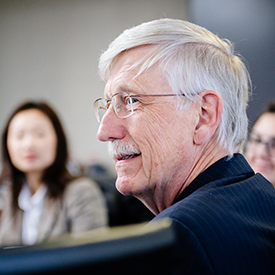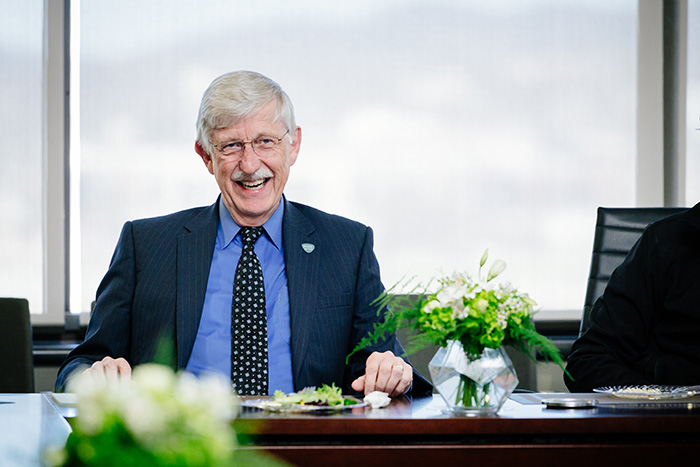 Speaking to a packed audience at UAB on March 6, Francis Collins, M.D., Ph.D., director of the National Institutes of Health (NIH), shared his picks of 10 “areas of particular excitement and promise” in biomedical research. (He also shared his thoughts on the then-emerging threat of COVID-19. While Alabama was still a week away from its first confirmed COVID-19 case, Collins told the UAB audience, “I will be amazed if you don’t have a case in the next week or two.”). At the conclusion of his talk, Collins shared his advice for young scientists.
Speaking to a packed audience at UAB on March 6, Francis Collins, M.D., Ph.D., director of the National Institutes of Health (NIH), shared his picks of 10 “areas of particular excitement and promise” in biomedical research. (He also shared his thoughts on the then-emerging threat of COVID-19. While Alabama was still a week away from its first confirmed COVID-19 case, Collins told the UAB audience, “I will be amazed if you don’t have a case in the next week or two.”). At the conclusion of his talk, Collins shared his advice for young scientists.
In nearly every area of research Collins discussed, UAB scientists are helping to lead the way. Here is Collins’ top 10 list, along with some of the UAB work ongoing in each area.
1 Single-cell sequencing
“I am so jazzed with what has become possible with the ability to study single cells and see what they are doing,” Collins said. “They have been out of our reach—now we have reached in. Whether you are studying rheumatoid arthritis, diabetes or the brain, you have the chance to ask each cell what it is doing.”
UAB Link: Robert Carter, M.D., the acting director of the National Institute of Arthritis and Musculoskeletal and Skin Diseases, was the longtime director of UAB’s Division of Clinical Immunology and Rheumatology. For the past several years, UAB researchers have been studying gene expression in subpopulations of immune cells in patients with rheumatoid arthritis.
2 New ways to see the brain
The NIH’s BRAIN Initiative is making this “the era where we are going to figure out how the brain works—all 86 billion neurons between your ears,” Collins said. The linchpin will be the development of tools to identify new brain cell types and circuits that will improve diagnosis, treatment, and prevention of autism, schizophrenia, Parkinson’s, and other neurological conditions, he said.
UAB Link: The lab of BRAIN Initiative grantee Harrison Walker, M.D., of the Department of Neurology, “has been developing a more sophisticated way to understand the benefits of deep brain stimulation for people with Parkinson’s and maybe other conditions,” Collins said.
3 Induced pluripotent stem cells
Researchers can now take a blood cell or skin cell and, by adding “four magic genes,” Collins explained, induce the cells to become stem cells. These induced pluripotent stem (iPS) cells can then in turn be differentiated into any number of different cell types. The NIH has invested in technology to put iPS-derived cells on specialized tissue chips. “You’ve got you on a chip,” Collins explained. “Some of us dream of a day where this might be the best way to figure out whether a drug intervention is going to work for you or you’re going to have a bad consequence.”
UAB Link: A cutting-edge cardiac tissue chip developed by a UAB team led by Palaniappan Sethu, Ph.D., of the Department of Biomedical Engineering and the Division of Cardiovascular Disease, “allows the development of cardiomyocytes that can be used to study heart failure” and other conditions, Collins said.
4 Microbiome advances
It is clear that “we are not an organism—we are a superorganism,” Collins said, formed with the trillions of microbes in and on our bodies. This microbiome plays a significant role not just in skin and intestinal diseases but “much more broadly.”
UAB Link: Work led by Casey Morrow, Ph.D., and Casey Weaver, M.D., co-directors of the Microbiome/Gnotobiotics Shared Facility, has revealed intriguing information about how antibiotics affect the gut microbiome, which has implications for understanding, preserving, and improving health, Collins said.
 NIH Director Francis Collins ate lunch with graduate students, post docs, and Medical Scientist Training Program students during his March visit to UAB.
NIH Director Francis Collins ate lunch with graduate students, post docs, and Medical Scientist Training Program students during his March visit to UAB.
5 Influenza vaccines
Another deadly influenza outbreak is likely in the future, Collins said. “What we need is not an influenza vaccine that you have to redesign every year, but something that would actually block influenza viruses,” he said. “Is that even possible? It just might be.”
UAB Link: We’re probably at least a decade away from a universal influenza vaccine. But work ongoing at UAB in the NIH-funded Antiviral Drug Discovery and Development Center, led by Distinguished Professor Richard Whitley, M.D., is focused on such an influenza breakthrough.
6 Addiction prevention and treatment of pain
The NIH has a role in tackling the opioid crisis, Collins said. The NIH’s Helping to End Addiction Long-term (HEAL) initiative is an “all-hands-on-deck” effort, he said, involving almost every NIH institute and center, with the goal of uncovering new targets for preventing addiction and improving pain treatment by developing non-addictive pain medicines.
UAB Link: NIH Centers of Excellence in Pain Education (CoEPE), including one at UAB, are hubs for the development, evaluation, and distribution of pain-management curriculum resources to enhance pain education for health care professionals.
7 Cancer immunotherapy
“We are all pretty darn jazzed about what’s happened in the past few years in terms of developing a new modality for treating cancer—we had surgery, we had radiation, we had chemotherapy, but now we’ve got immunotherapy,” Collins said. Educating immune system cells to go after cancer in therapies such as CAR-T cell therapy is “the hottest science in cancer,” he said. “I would argue this is a really exciting moment where the oncologists and the immunologists together are doing amazing things.”
UAB Link: “I had to say something about immunology since I’m at UAB given that Max Cooper, who just got the Lasker Award for [his] B and T cell discoveries, was here,” Collins said. “This is a place I would hope where lots of interesting ideas are going to continue to emerge.”
8 All of Us Research Program
The NIH All of Us Research Program aims to enroll a million Americans—to move away from the one-size-fits-all approach to medicine and “really understand individual differences,” Collins said. The program, which launched in 2018, has a prevention rather than a disease treatment approach; it is collecting information on environmental exposures, health practices, diet, exercise, and more, in addition to genetics, from participants.
UAB Link: “UAB has been doing a fantastic job of enrolling participants,” Collins noted. In fact, the Southern Network of the All of Us Research Program, led by UAB, has consistently been at the top in terms of nationwide enrollment.
9 Rare diseases
“The NIH needs to play a special role” because many diseases are so rare that pharmaceutical companies will not focus on them, Collins said. “We need to find answers that are scalable, so you don’t have to come up with a strategy for all 6,500 rare diseases.”
UAB Link: The Undiagnosed Diseases Network, including a UAB site led by Chief Genomics Officer Bruce Korf, M.D., Ph.D., is a national network that brings together a wide range of experts to help patients. Patients and providers can also contact the UAB Precision Medicine Institute, led by Director Matt Might, Ph.D. The institute develops precisely targeted treatments based on a patient’s unique genetic makeup.
Collins also credited UAB’s Tim Townes, Ph.D., professor emeritus in the Department of Biochemistry and Molecular Genetics, for developing “the most significantly accurate model of sickle cell disease in a mouse which has been a great service to the [research] community.” UAB is now participating in an exciting clinical trial of a gene-editing technique to treat sickle cell along with other new targeted therapies for the devastating blood disease.
10 Diversity in the scientific workforce
“We know that science, like everything else, is more productive when teams are diverse,” Collins said. “My number one priority as NIH director is to be sure we are doing everything we can to nurture and encourage the best and brightest to join this effort.”
UAB Link: The Neuroscience Roadmap Scholars Program at UAB, supported by an NIH R25 grant, is designed to enhance engagement and retention of under-represented graduate trainees in the neuroscience workforce. It is one of several UAB initiatives to increase diversity in science. These include several programs from the UAB Minority Health and Health Disparities Research Center that support minority students from the undergraduate level to postdocs.
By Matt Windsor